Analyzing HRM Functions & Ethical Concerns at Mainfreight - DBN507
VerifiedAdded on 2023/04/25
|10
|2661
|376
Report
AI Summary
This report provides an overview of Human Resource Management (HRM) practices within Mainfreight Limited, a major logistics corporation in New Zealand. It examines key HRM roles such as strategic partner, employee champion, and change agent, and discusses the five HRM functions used by the organization: training and development, public relations, compensation and benefits, staffing, and employee motivation. The report also addresses moral, ethical, regulatory, and practical issues related to human resource planning, job analysis, and job design within Mainfreight's logistics department. Specifically, it explores challenges like lack of employee cooperation, management support, technostress, and skill development in human resource planning. In job analysis, ethical issues such as job distribution and task revision are discussed, along with regulatory issues concerning time and resource information and alternative work patterns. The report further examines discriminatory recruitment practices, misleading job advertisements, interviewing skills, and the lack of understanding between recruiters and hiring managers. Finally, it addresses the ethical problems of salary transparency and EEO legislation in the selection process. The document concludes by emphasizing the importance of HRM in achieving Mainfreight's corporate objectives effectively.
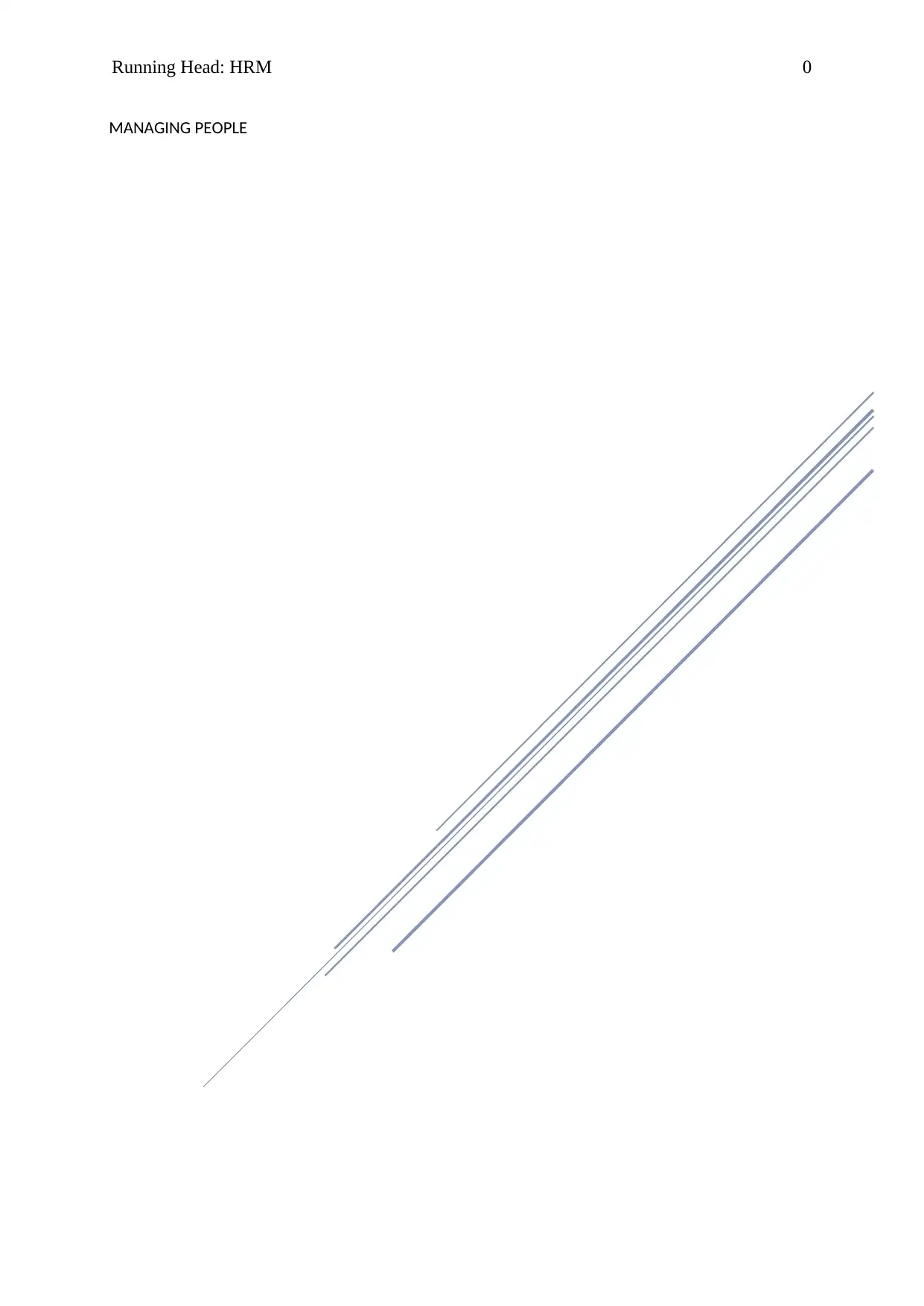
Running Head: HRM 0
MANAGING PEOPLE
MANAGING PEOPLE
Paraphrase This Document
Need a fresh take? Get an instant paraphrase of this document with our AI Paraphraser
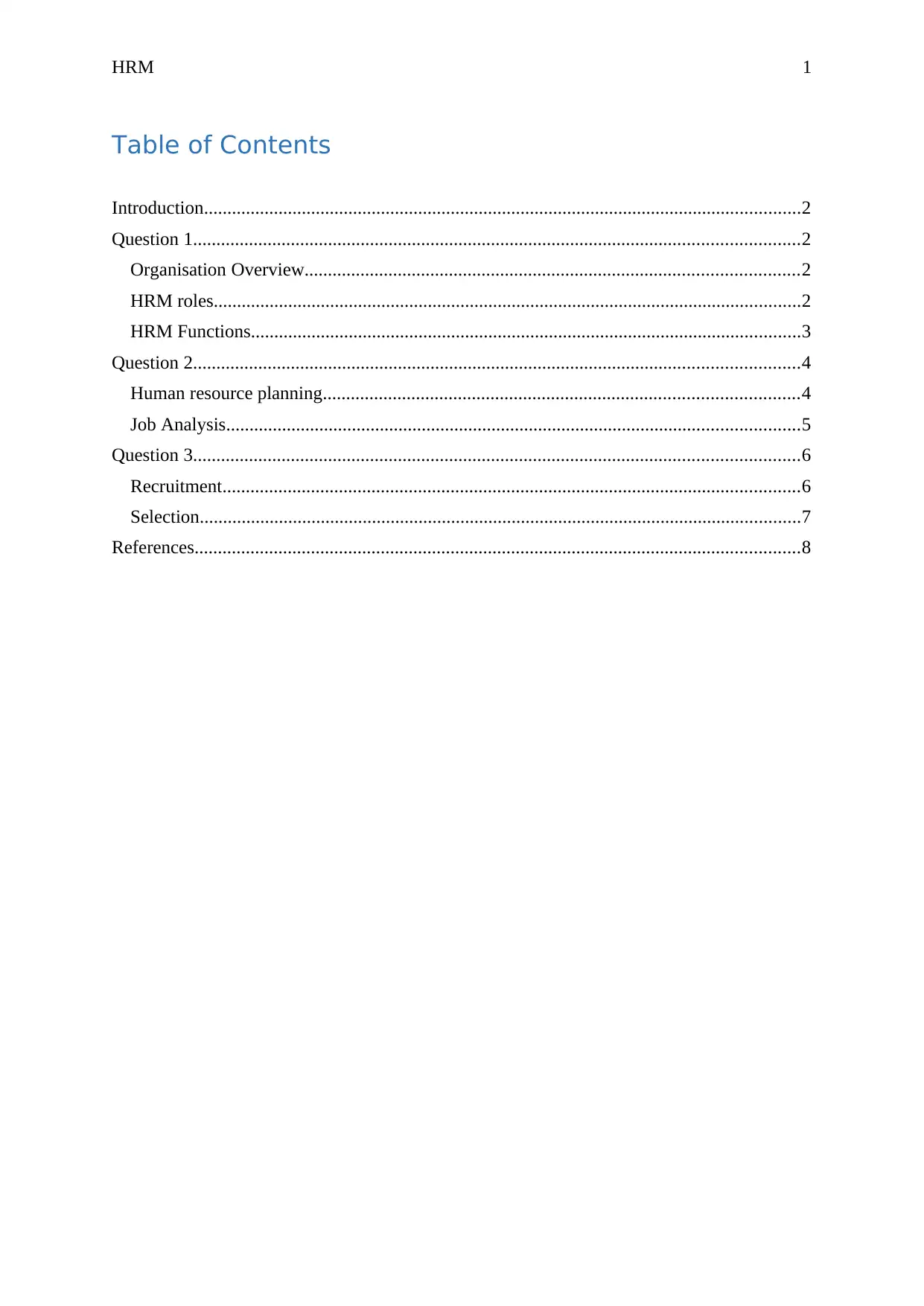
HRM 1
Table of Contents
Introduction................................................................................................................................2
Question 1..................................................................................................................................2
Organisation Overview..........................................................................................................2
HRM roles..............................................................................................................................2
HRM Functions......................................................................................................................3
Question 2..................................................................................................................................4
Human resource planning......................................................................................................4
Job Analysis...........................................................................................................................5
Question 3..................................................................................................................................6
Recruitment............................................................................................................................6
Selection.................................................................................................................................7
References..................................................................................................................................8
Table of Contents
Introduction................................................................................................................................2
Question 1..................................................................................................................................2
Organisation Overview..........................................................................................................2
HRM roles..............................................................................................................................2
HRM Functions......................................................................................................................3
Question 2..................................................................................................................................4
Human resource planning......................................................................................................4
Job Analysis...........................................................................................................................5
Question 3..................................................................................................................................6
Recruitment............................................................................................................................6
Selection.................................................................................................................................7
References..................................................................................................................................8
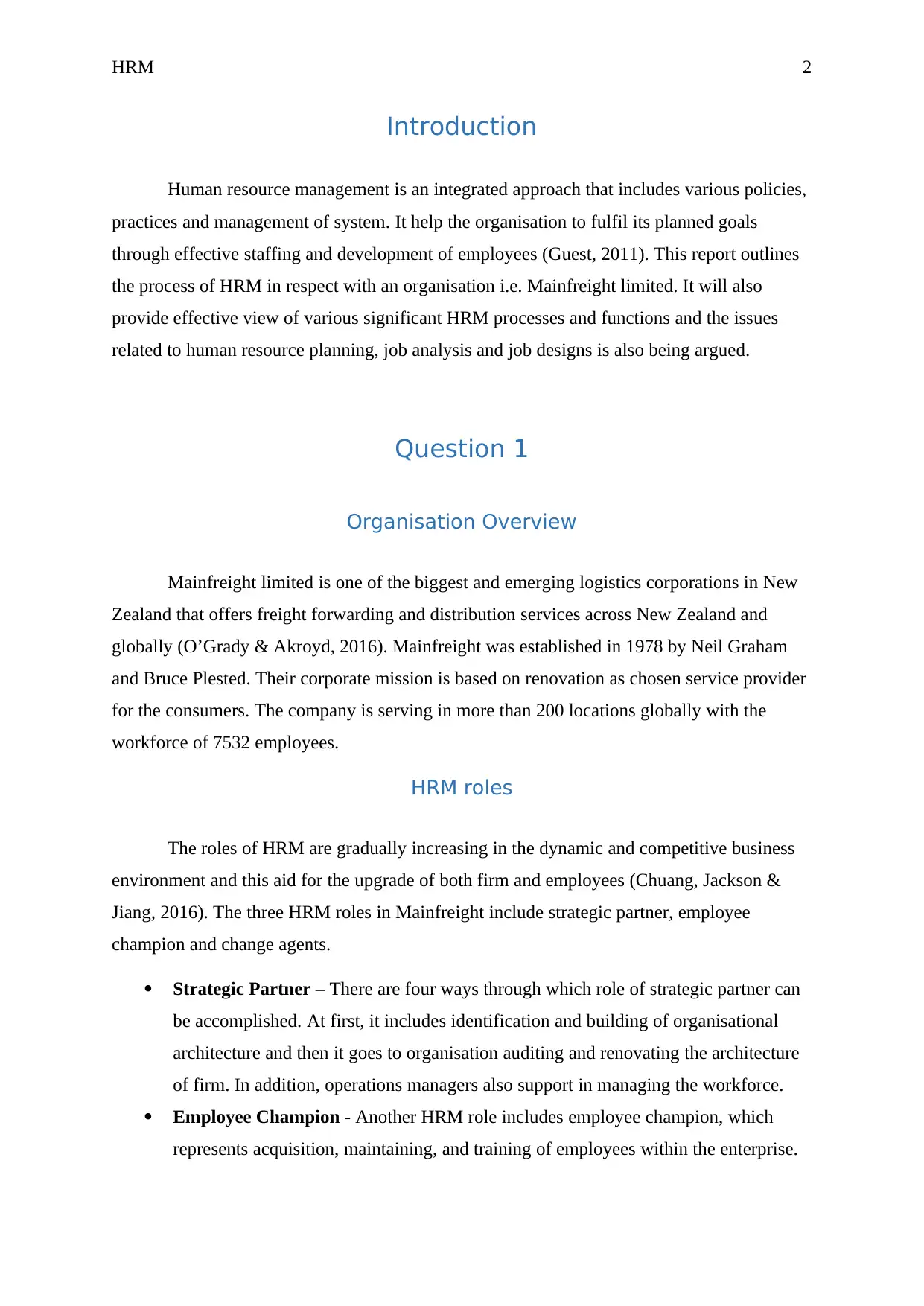
HRM 2
Introduction
Human resource management is an integrated approach that includes various policies,
practices and management of system. It help the organisation to fulfil its planned goals
through effective staffing and development of employees (Guest, 2011). This report outlines
the process of HRM in respect with an organisation i.e. Mainfreight limited. It will also
provide effective view of various significant HRM processes and functions and the issues
related to human resource planning, job analysis and job designs is also being argued.
Question 1
Organisation Overview
Mainfreight limited is one of the biggest and emerging logistics corporations in New
Zealand that offers freight forwarding and distribution services across New Zealand and
globally (O’Grady & Akroyd, 2016). Mainfreight was established in 1978 by Neil Graham
and Bruce Plested. Their corporate mission is based on renovation as chosen service provider
for the consumers. The company is serving in more than 200 locations globally with the
workforce of 7532 employees.
HRM roles
The roles of HRM are gradually increasing in the dynamic and competitive business
environment and this aid for the upgrade of both firm and employees (Chuang, Jackson &
Jiang, 2016). The three HRM roles in Mainfreight include strategic partner, employee
champion and change agents.
Strategic Partner – There are four ways through which role of strategic partner can
be accomplished. At first, it includes identification and building of organisational
architecture and then it goes to organisation auditing and renovating the architecture
of firm. In addition, operations managers also support in managing the workforce.
Employee Champion - Another HRM role includes employee champion, which
represents acquisition, maintaining, and training of employees within the enterprise.
Introduction
Human resource management is an integrated approach that includes various policies,
practices and management of system. It help the organisation to fulfil its planned goals
through effective staffing and development of employees (Guest, 2011). This report outlines
the process of HRM in respect with an organisation i.e. Mainfreight limited. It will also
provide effective view of various significant HRM processes and functions and the issues
related to human resource planning, job analysis and job designs is also being argued.
Question 1
Organisation Overview
Mainfreight limited is one of the biggest and emerging logistics corporations in New
Zealand that offers freight forwarding and distribution services across New Zealand and
globally (O’Grady & Akroyd, 2016). Mainfreight was established in 1978 by Neil Graham
and Bruce Plested. Their corporate mission is based on renovation as chosen service provider
for the consumers. The company is serving in more than 200 locations globally with the
workforce of 7532 employees.
HRM roles
The roles of HRM are gradually increasing in the dynamic and competitive business
environment and this aid for the upgrade of both firm and employees (Chuang, Jackson &
Jiang, 2016). The three HRM roles in Mainfreight include strategic partner, employee
champion and change agents.
Strategic Partner – There are four ways through which role of strategic partner can
be accomplished. At first, it includes identification and building of organisational
architecture and then it goes to organisation auditing and renovating the architecture
of firm. In addition, operations managers also support in managing the workforce.
Employee Champion - Another HRM role includes employee champion, which
represents acquisition, maintaining, and training of employees within the enterprise.
⊘ This is a preview!⊘
Do you want full access?
Subscribe today to unlock all pages.

Trusted by 1+ million students worldwide
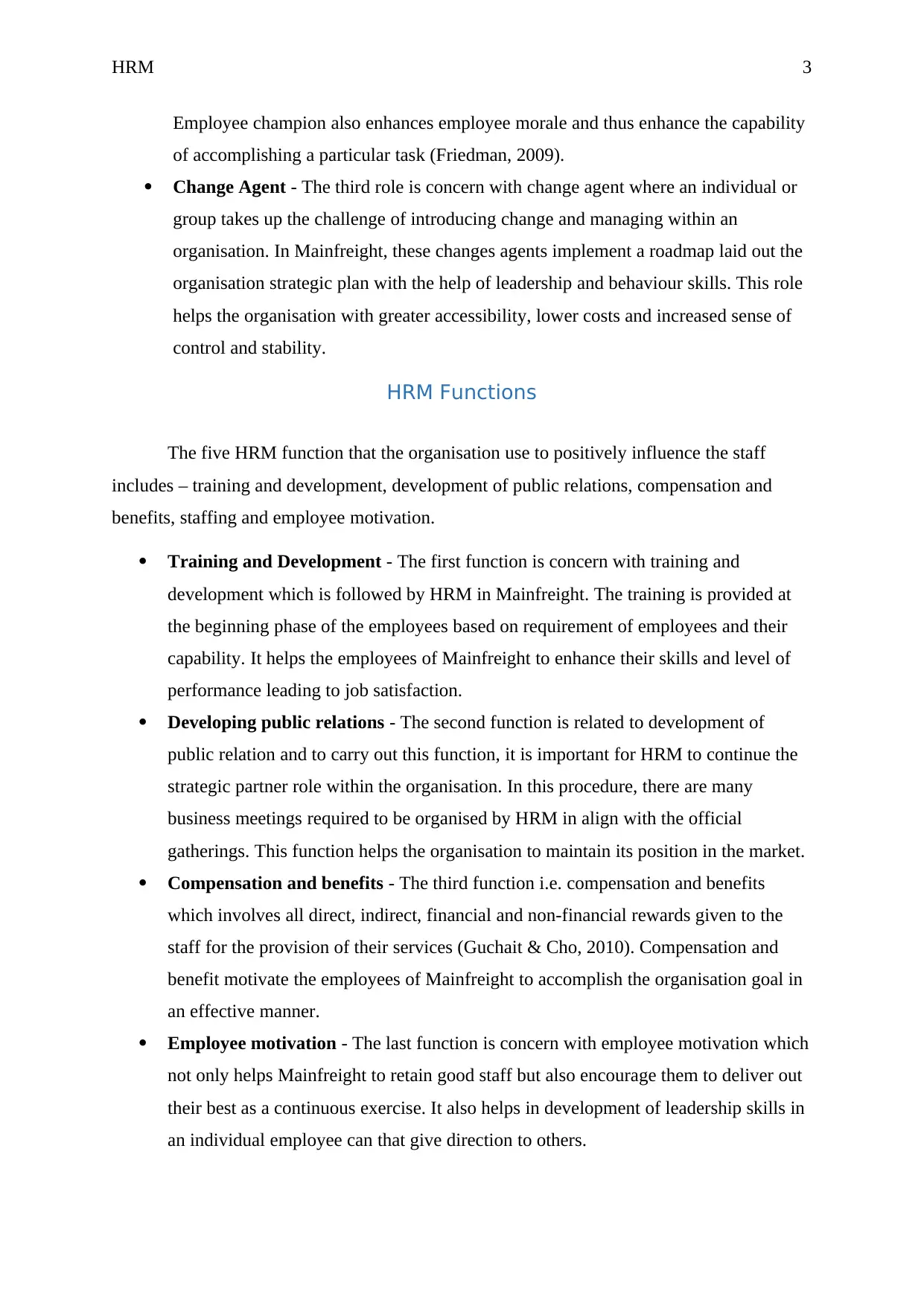
HRM 3
Employee champion also enhances employee morale and thus enhance the capability
of accomplishing a particular task (Friedman, 2009).
Change Agent - The third role is concern with change agent where an individual or
group takes up the challenge of introducing change and managing within an
organisation. In Mainfreight, these changes agents implement a roadmap laid out the
organisation strategic plan with the help of leadership and behaviour skills. This role
helps the organisation with greater accessibility, lower costs and increased sense of
control and stability.
HRM Functions
The five HRM function that the organisation use to positively influence the staff
includes – training and development, development of public relations, compensation and
benefits, staffing and employee motivation.
Training and Development - The first function is concern with training and
development which is followed by HRM in Mainfreight. The training is provided at
the beginning phase of the employees based on requirement of employees and their
capability. It helps the employees of Mainfreight to enhance their skills and level of
performance leading to job satisfaction.
Developing public relations - The second function is related to development of
public relation and to carry out this function, it is important for HRM to continue the
strategic partner role within the organisation. In this procedure, there are many
business meetings required to be organised by HRM in align with the official
gatherings. This function helps the organisation to maintain its position in the market.
Compensation and benefits - The third function i.e. compensation and benefits
which involves all direct, indirect, financial and non-financial rewards given to the
staff for the provision of their services (Guchait & Cho, 2010). Compensation and
benefit motivate the employees of Mainfreight to accomplish the organisation goal in
an effective manner.
Employee motivation - The last function is concern with employee motivation which
not only helps Mainfreight to retain good staff but also encourage them to deliver out
their best as a continuous exercise. It also helps in development of leadership skills in
an individual employee can that give direction to others.
Employee champion also enhances employee morale and thus enhance the capability
of accomplishing a particular task (Friedman, 2009).
Change Agent - The third role is concern with change agent where an individual or
group takes up the challenge of introducing change and managing within an
organisation. In Mainfreight, these changes agents implement a roadmap laid out the
organisation strategic plan with the help of leadership and behaviour skills. This role
helps the organisation with greater accessibility, lower costs and increased sense of
control and stability.
HRM Functions
The five HRM function that the organisation use to positively influence the staff
includes – training and development, development of public relations, compensation and
benefits, staffing and employee motivation.
Training and Development - The first function is concern with training and
development which is followed by HRM in Mainfreight. The training is provided at
the beginning phase of the employees based on requirement of employees and their
capability. It helps the employees of Mainfreight to enhance their skills and level of
performance leading to job satisfaction.
Developing public relations - The second function is related to development of
public relation and to carry out this function, it is important for HRM to continue the
strategic partner role within the organisation. In this procedure, there are many
business meetings required to be organised by HRM in align with the official
gatherings. This function helps the organisation to maintain its position in the market.
Compensation and benefits - The third function i.e. compensation and benefits
which involves all direct, indirect, financial and non-financial rewards given to the
staff for the provision of their services (Guchait & Cho, 2010). Compensation and
benefit motivate the employees of Mainfreight to accomplish the organisation goal in
an effective manner.
Employee motivation - The last function is concern with employee motivation which
not only helps Mainfreight to retain good staff but also encourage them to deliver out
their best as a continuous exercise. It also helps in development of leadership skills in
an individual employee can that give direction to others.
Paraphrase This Document
Need a fresh take? Get an instant paraphrase of this document with our AI Paraphraser
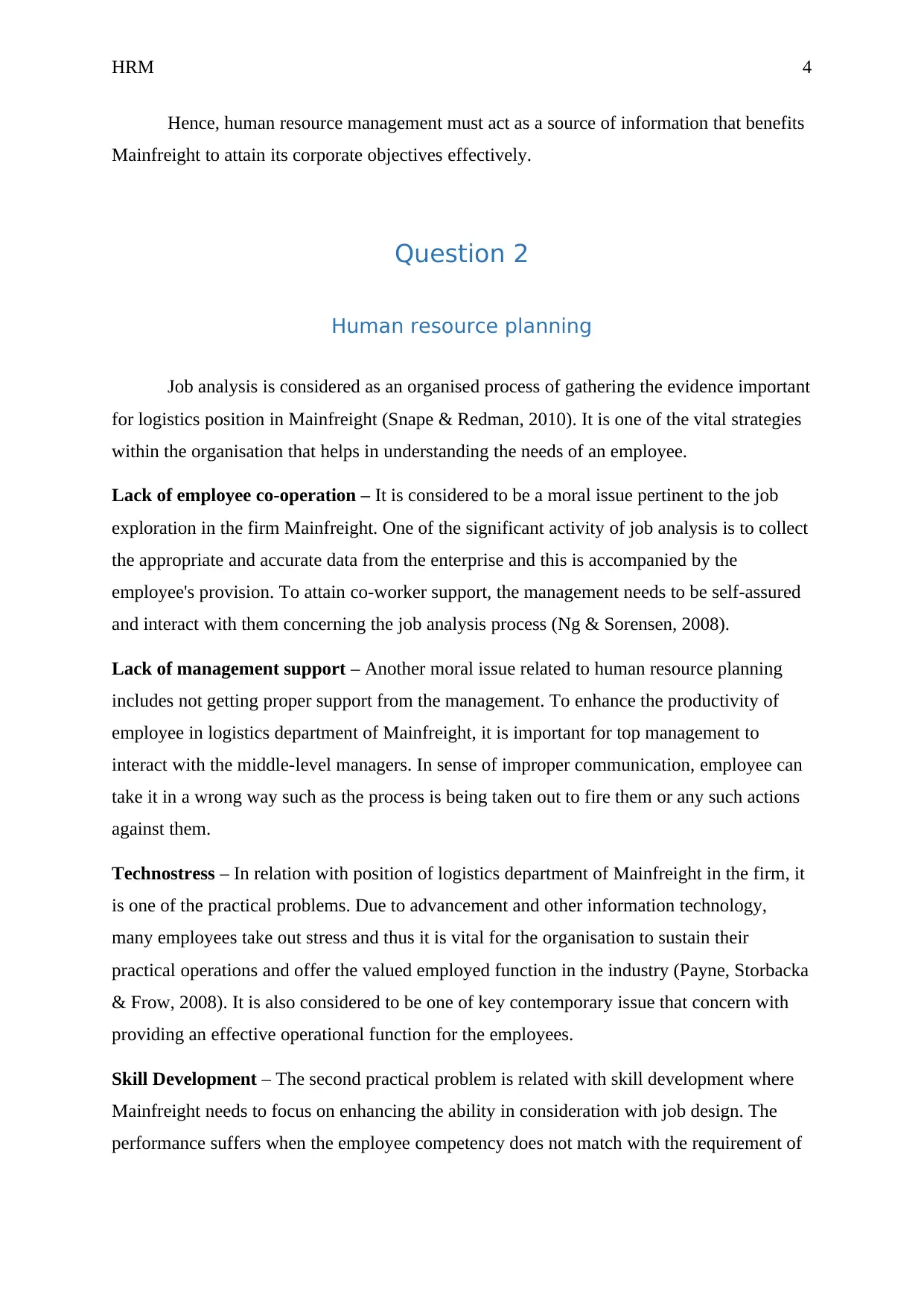
HRM 4
Hence, human resource management must act as a source of information that benefits
Mainfreight to attain its corporate objectives effectively.
Question 2
Human resource planning
Job analysis is considered as an organised process of gathering the evidence important
for logistics position in Mainfreight (Snape & Redman, 2010). It is one of the vital strategies
within the organisation that helps in understanding the needs of an employee.
Lack of employee co-operation – It is considered to be a moral issue pertinent to the job
exploration in the firm Mainfreight. One of the significant activity of job analysis is to collect
the appropriate and accurate data from the enterprise and this is accompanied by the
employee's provision. To attain co-worker support, the management needs to be self-assured
and interact with them concerning the job analysis process (Ng & Sorensen, 2008).
Lack of management support – Another moral issue related to human resource planning
includes not getting proper support from the management. To enhance the productivity of
employee in logistics department of Mainfreight, it is important for top management to
interact with the middle-level managers. In sense of improper communication, employee can
take it in a wrong way such as the process is being taken out to fire them or any such actions
against them.
Technostress – In relation with position of logistics department of Mainfreight in the firm, it
is one of the practical problems. Due to advancement and other information technology,
many employees take out stress and thus it is vital for the organisation to sustain their
practical operations and offer the valued employed function in the industry (Payne, Storbacka
& Frow, 2008). It is also considered to be one of key contemporary issue that concern with
providing an effective operational function for the employees.
Skill Development – The second practical problem is related with skill development where
Mainfreight needs to focus on enhancing the ability in consideration with job design. The
performance suffers when the employee competency does not match with the requirement of
Hence, human resource management must act as a source of information that benefits
Mainfreight to attain its corporate objectives effectively.
Question 2
Human resource planning
Job analysis is considered as an organised process of gathering the evidence important
for logistics position in Mainfreight (Snape & Redman, 2010). It is one of the vital strategies
within the organisation that helps in understanding the needs of an employee.
Lack of employee co-operation – It is considered to be a moral issue pertinent to the job
exploration in the firm Mainfreight. One of the significant activity of job analysis is to collect
the appropriate and accurate data from the enterprise and this is accompanied by the
employee's provision. To attain co-worker support, the management needs to be self-assured
and interact with them concerning the job analysis process (Ng & Sorensen, 2008).
Lack of management support – Another moral issue related to human resource planning
includes not getting proper support from the management. To enhance the productivity of
employee in logistics department of Mainfreight, it is important for top management to
interact with the middle-level managers. In sense of improper communication, employee can
take it in a wrong way such as the process is being taken out to fire them or any such actions
against them.
Technostress – In relation with position of logistics department of Mainfreight in the firm, it
is one of the practical problems. Due to advancement and other information technology,
many employees take out stress and thus it is vital for the organisation to sustain their
practical operations and offer the valued employed function in the industry (Payne, Storbacka
& Frow, 2008). It is also considered to be one of key contemporary issue that concern with
providing an effective operational function for the employees.
Skill Development – The second practical problem is related with skill development where
Mainfreight needs to focus on enhancing the ability in consideration with job design. The
performance suffers when the employee competency does not match with the requirement of
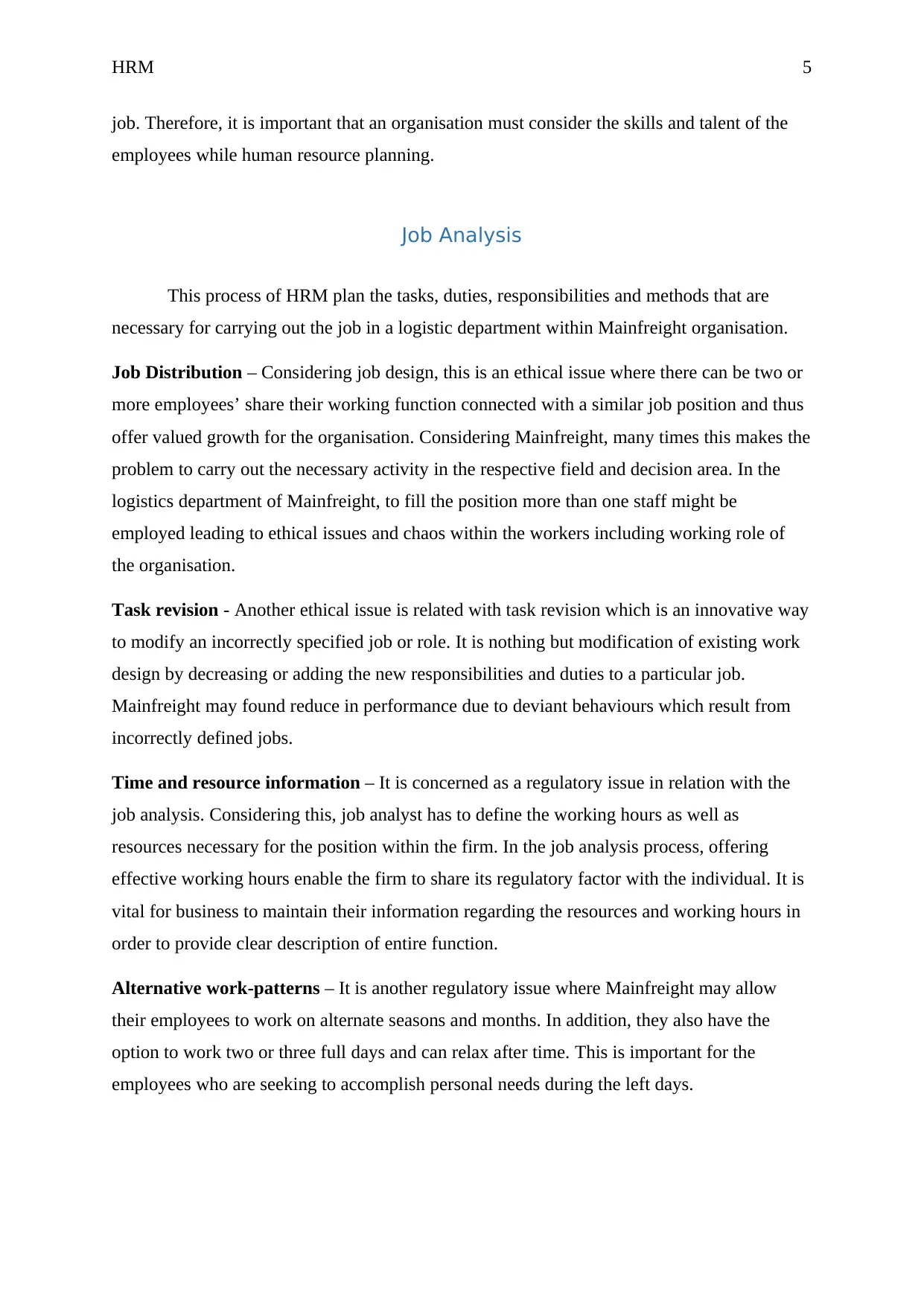
HRM 5
job. Therefore, it is important that an organisation must consider the skills and talent of the
employees while human resource planning.
Job Analysis
This process of HRM plan the tasks, duties, responsibilities and methods that are
necessary for carrying out the job in a logistic department within Mainfreight organisation.
Job Distribution – Considering job design, this is an ethical issue where there can be two or
more employees’ share their working function connected with a similar job position and thus
offer valued growth for the organisation. Considering Mainfreight, many times this makes the
problem to carry out the necessary activity in the respective field and decision area. In the
logistics department of Mainfreight, to fill the position more than one staff might be
employed leading to ethical issues and chaos within the workers including working role of
the organisation.
Task revision - Another ethical issue is related with task revision which is an innovative way
to modify an incorrectly specified job or role. It is nothing but modification of existing work
design by decreasing or adding the new responsibilities and duties to a particular job.
Mainfreight may found reduce in performance due to deviant behaviours which result from
incorrectly defined jobs.
Time and resource information – It is concerned as a regulatory issue in relation with the
job analysis. Considering this, job analyst has to define the working hours as well as
resources necessary for the position within the firm. In the job analysis process, offering
effective working hours enable the firm to share its regulatory factor with the individual. It is
vital for business to maintain their information regarding the resources and working hours in
order to provide clear description of entire function.
Alternative work-patterns – It is another regulatory issue where Mainfreight may allow
their employees to work on alternate seasons and months. In addition, they also have the
option to work two or three full days and can relax after time. This is important for the
employees who are seeking to accomplish personal needs during the left days.
job. Therefore, it is important that an organisation must consider the skills and talent of the
employees while human resource planning.
Job Analysis
This process of HRM plan the tasks, duties, responsibilities and methods that are
necessary for carrying out the job in a logistic department within Mainfreight organisation.
Job Distribution – Considering job design, this is an ethical issue where there can be two or
more employees’ share their working function connected with a similar job position and thus
offer valued growth for the organisation. Considering Mainfreight, many times this makes the
problem to carry out the necessary activity in the respective field and decision area. In the
logistics department of Mainfreight, to fill the position more than one staff might be
employed leading to ethical issues and chaos within the workers including working role of
the organisation.
Task revision - Another ethical issue is related with task revision which is an innovative way
to modify an incorrectly specified job or role. It is nothing but modification of existing work
design by decreasing or adding the new responsibilities and duties to a particular job.
Mainfreight may found reduce in performance due to deviant behaviours which result from
incorrectly defined jobs.
Time and resource information – It is concerned as a regulatory issue in relation with the
job analysis. Considering this, job analyst has to define the working hours as well as
resources necessary for the position within the firm. In the job analysis process, offering
effective working hours enable the firm to share its regulatory factor with the individual. It is
vital for business to maintain their information regarding the resources and working hours in
order to provide clear description of entire function.
Alternative work-patterns – It is another regulatory issue where Mainfreight may allow
their employees to work on alternate seasons and months. In addition, they also have the
option to work two or three full days and can relax after time. This is important for the
employees who are seeking to accomplish personal needs during the left days.
⊘ This is a preview!⊘
Do you want full access?
Subscribe today to unlock all pages.

Trusted by 1+ million students worldwide
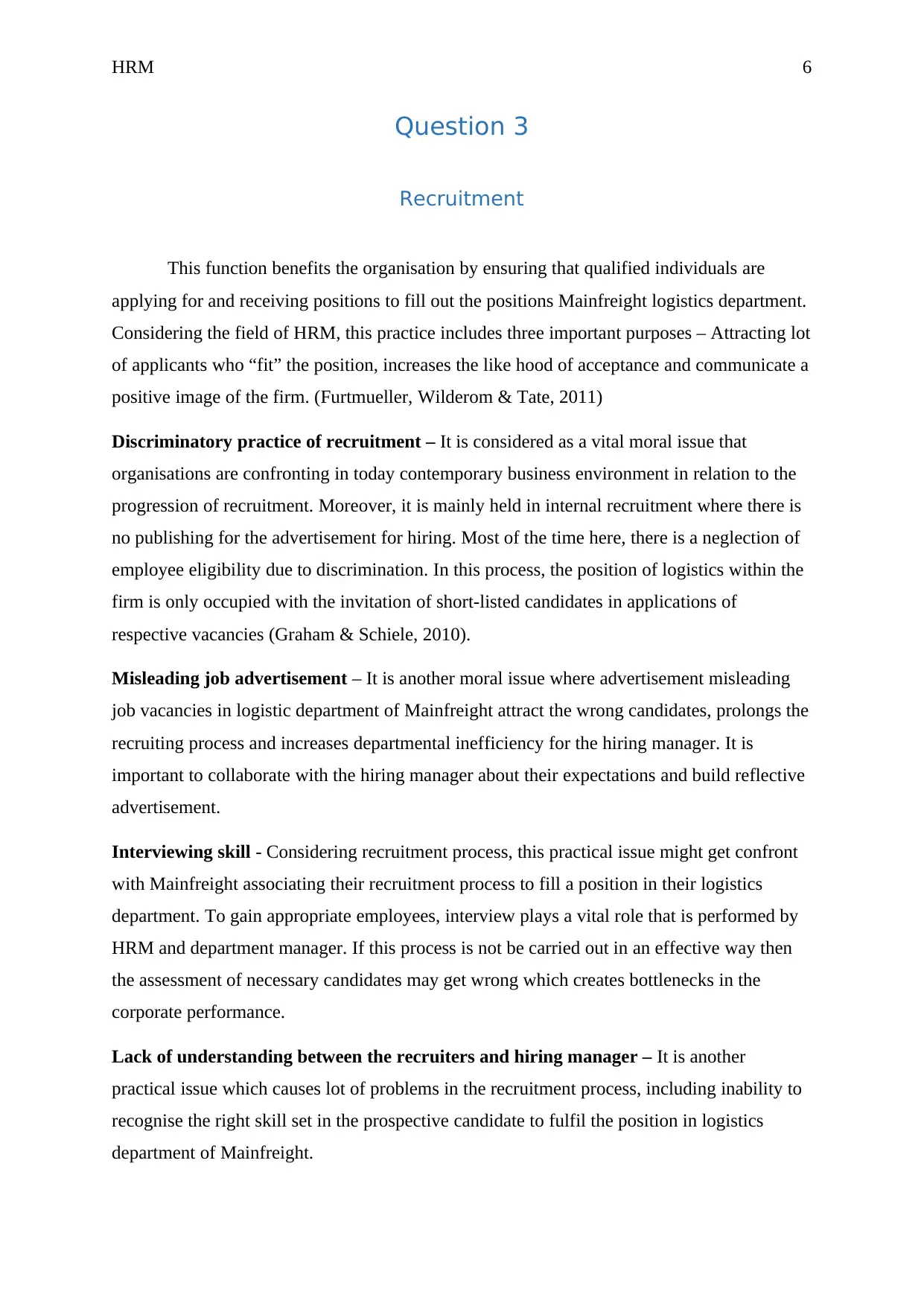
HRM 6
Question 3
Recruitment
This function benefits the organisation by ensuring that qualified individuals are
applying for and receiving positions to fill out the positions Mainfreight logistics department.
Considering the field of HRM, this practice includes three important purposes – Attracting lot
of applicants who “fit” the position, increases the like hood of acceptance and communicate a
positive image of the firm. (Furtmueller, Wilderom & Tate, 2011)
Discriminatory practice of recruitment – It is considered as a vital moral issue that
organisations are confronting in today contemporary business environment in relation to the
progression of recruitment. Moreover, it is mainly held in internal recruitment where there is
no publishing for the advertisement for hiring. Most of the time here, there is a neglection of
employee eligibility due to discrimination. In this process, the position of logistics within the
firm is only occupied with the invitation of short-listed candidates in applications of
respective vacancies (Graham & Schiele, 2010).
Misleading job advertisement – It is another moral issue where advertisement misleading
job vacancies in logistic department of Mainfreight attract the wrong candidates, prolongs the
recruiting process and increases departmental inefficiency for the hiring manager. It is
important to collaborate with the hiring manager about their expectations and build reflective
advertisement.
Interviewing skill - Considering recruitment process, this practical issue might get confront
with Mainfreight associating their recruitment process to fill a position in their logistics
department. To gain appropriate employees, interview plays a vital role that is performed by
HRM and department manager. If this process is not be carried out in an effective way then
the assessment of necessary candidates may get wrong which creates bottlenecks in the
corporate performance.
Lack of understanding between the recruiters and hiring manager – It is another
practical issue which causes lot of problems in the recruitment process, including inability to
recognise the right skill set in the prospective candidate to fulfil the position in logistics
department of Mainfreight.
Question 3
Recruitment
This function benefits the organisation by ensuring that qualified individuals are
applying for and receiving positions to fill out the positions Mainfreight logistics department.
Considering the field of HRM, this practice includes three important purposes – Attracting lot
of applicants who “fit” the position, increases the like hood of acceptance and communicate a
positive image of the firm. (Furtmueller, Wilderom & Tate, 2011)
Discriminatory practice of recruitment – It is considered as a vital moral issue that
organisations are confronting in today contemporary business environment in relation to the
progression of recruitment. Moreover, it is mainly held in internal recruitment where there is
no publishing for the advertisement for hiring. Most of the time here, there is a neglection of
employee eligibility due to discrimination. In this process, the position of logistics within the
firm is only occupied with the invitation of short-listed candidates in applications of
respective vacancies (Graham & Schiele, 2010).
Misleading job advertisement – It is another moral issue where advertisement misleading
job vacancies in logistic department of Mainfreight attract the wrong candidates, prolongs the
recruiting process and increases departmental inefficiency for the hiring manager. It is
important to collaborate with the hiring manager about their expectations and build reflective
advertisement.
Interviewing skill - Considering recruitment process, this practical issue might get confront
with Mainfreight associating their recruitment process to fill a position in their logistics
department. To gain appropriate employees, interview plays a vital role that is performed by
HRM and department manager. If this process is not be carried out in an effective way then
the assessment of necessary candidates may get wrong which creates bottlenecks in the
corporate performance.
Lack of understanding between the recruiters and hiring manager – It is another
practical issue which causes lot of problems in the recruitment process, including inability to
recognise the right skill set in the prospective candidate to fulfil the position in logistics
department of Mainfreight.
Paraphrase This Document
Need a fresh take? Get an instant paraphrase of this document with our AI Paraphraser
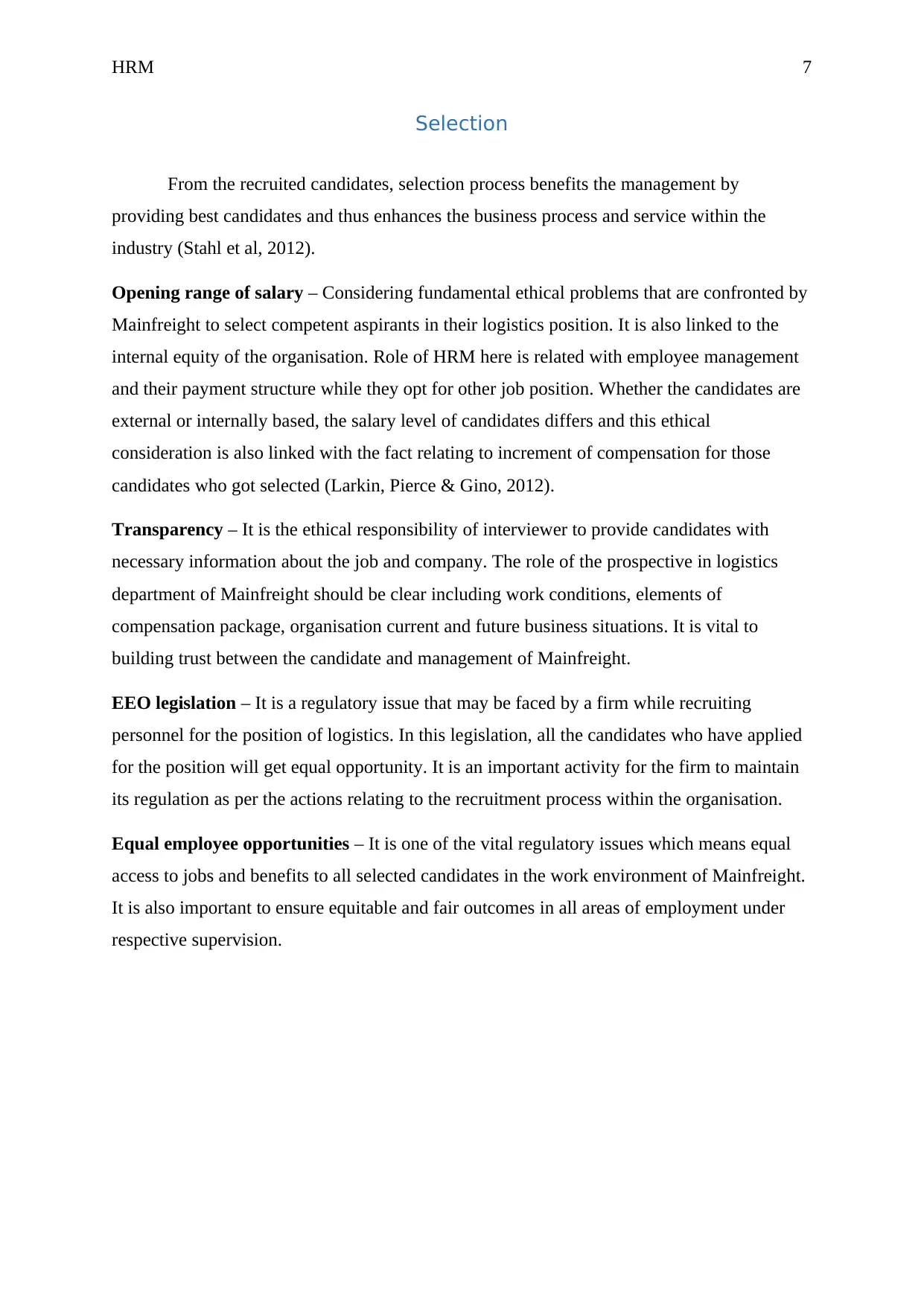
HRM 7
Selection
From the recruited candidates, selection process benefits the management by
providing best candidates and thus enhances the business process and service within the
industry (Stahl et al, 2012).
Opening range of salary – Considering fundamental ethical problems that are confronted by
Mainfreight to select competent aspirants in their logistics position. It is also linked to the
internal equity of the organisation. Role of HRM here is related with employee management
and their payment structure while they opt for other job position. Whether the candidates are
external or internally based, the salary level of candidates differs and this ethical
consideration is also linked with the fact relating to increment of compensation for those
candidates who got selected (Larkin, Pierce & Gino, 2012).
Transparency – It is the ethical responsibility of interviewer to provide candidates with
necessary information about the job and company. The role of the prospective in logistics
department of Mainfreight should be clear including work conditions, elements of
compensation package, organisation current and future business situations. It is vital to
building trust between the candidate and management of Mainfreight.
EEO legislation – It is a regulatory issue that may be faced by a firm while recruiting
personnel for the position of logistics. In this legislation, all the candidates who have applied
for the position will get equal opportunity. It is an important activity for the firm to maintain
its regulation as per the actions relating to the recruitment process within the organisation.
Equal employee opportunities – It is one of the vital regulatory issues which means equal
access to jobs and benefits to all selected candidates in the work environment of Mainfreight.
It is also important to ensure equitable and fair outcomes in all areas of employment under
respective supervision.
Selection
From the recruited candidates, selection process benefits the management by
providing best candidates and thus enhances the business process and service within the
industry (Stahl et al, 2012).
Opening range of salary – Considering fundamental ethical problems that are confronted by
Mainfreight to select competent aspirants in their logistics position. It is also linked to the
internal equity of the organisation. Role of HRM here is related with employee management
and their payment structure while they opt for other job position. Whether the candidates are
external or internally based, the salary level of candidates differs and this ethical
consideration is also linked with the fact relating to increment of compensation for those
candidates who got selected (Larkin, Pierce & Gino, 2012).
Transparency – It is the ethical responsibility of interviewer to provide candidates with
necessary information about the job and company. The role of the prospective in logistics
department of Mainfreight should be clear including work conditions, elements of
compensation package, organisation current and future business situations. It is vital to
building trust between the candidate and management of Mainfreight.
EEO legislation – It is a regulatory issue that may be faced by a firm while recruiting
personnel for the position of logistics. In this legislation, all the candidates who have applied
for the position will get equal opportunity. It is an important activity for the firm to maintain
its regulation as per the actions relating to the recruitment process within the organisation.
Equal employee opportunities – It is one of the vital regulatory issues which means equal
access to jobs and benefits to all selected candidates in the work environment of Mainfreight.
It is also important to ensure equitable and fair outcomes in all areas of employment under
respective supervision.
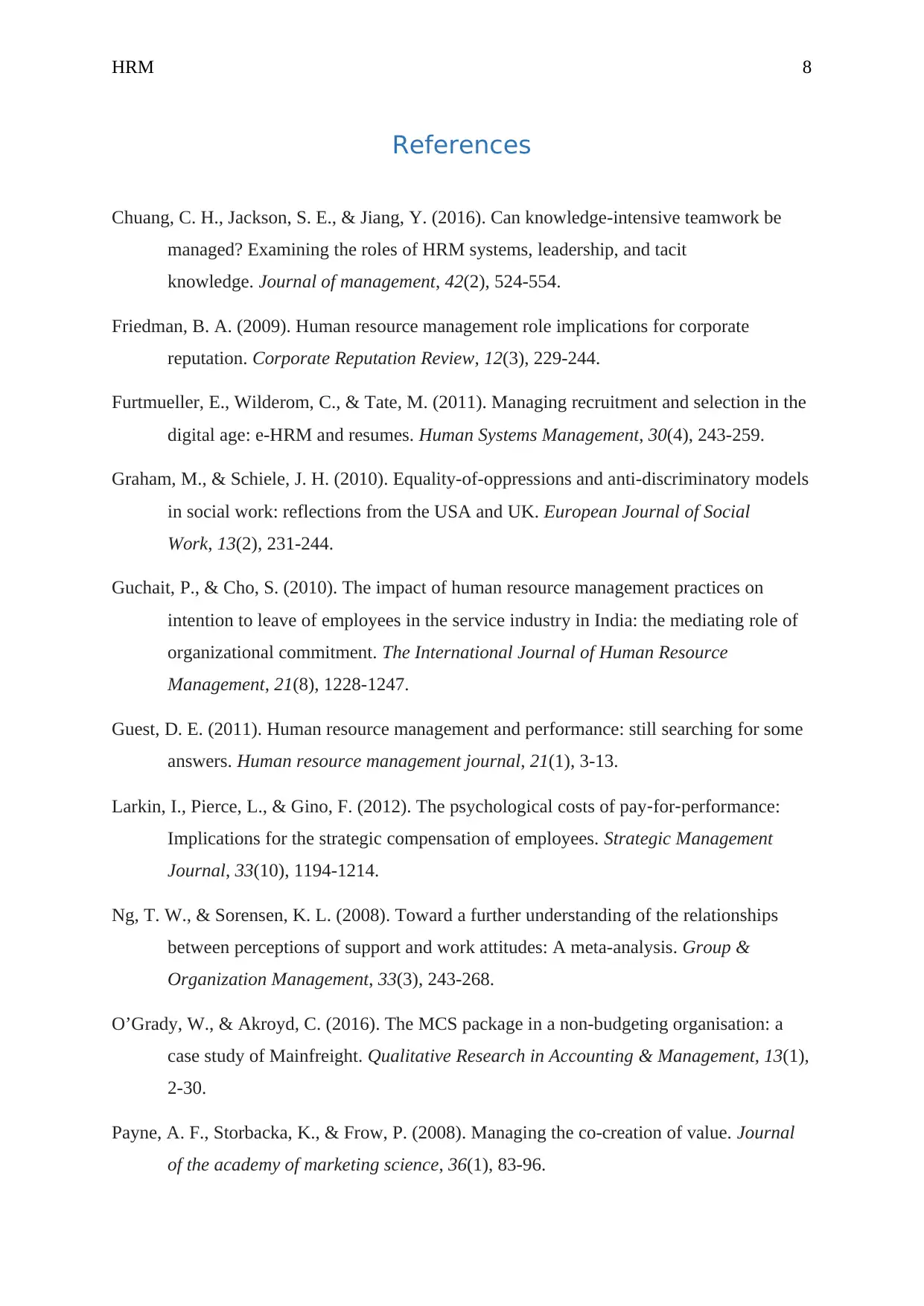
HRM 8
References
Chuang, C. H., Jackson, S. E., & Jiang, Y. (2016). Can knowledge-intensive teamwork be
managed? Examining the roles of HRM systems, leadership, and tacit
knowledge. Journal of management, 42(2), 524-554.
Friedman, B. A. (2009). Human resource management role implications for corporate
reputation. Corporate Reputation Review, 12(3), 229-244.
Furtmueller, E., Wilderom, C., & Tate, M. (2011). Managing recruitment and selection in the
digital age: e-HRM and resumes. Human Systems Management, 30(4), 243-259.
Graham, M., & Schiele, J. H. (2010). Equality-of-oppressions and anti-discriminatory models
in social work: reflections from the USA and UK. European Journal of Social
Work, 13(2), 231-244.
Guchait, P., & Cho, S. (2010). The impact of human resource management practices on
intention to leave of employees in the service industry in India: the mediating role of
organizational commitment. The International Journal of Human Resource
Management, 21(8), 1228-1247.
Guest, D. E. (2011). Human resource management and performance: still searching for some
answers. Human resource management journal, 21(1), 3-13.
Larkin, I., Pierce, L., & Gino, F. (2012). The psychological costs of pay‐for‐performance:
Implications for the strategic compensation of employees. Strategic Management
Journal, 33(10), 1194-1214.
Ng, T. W., & Sorensen, K. L. (2008). Toward a further understanding of the relationships
between perceptions of support and work attitudes: A meta-analysis. Group &
Organization Management, 33(3), 243-268.
O’Grady, W., & Akroyd, C. (2016). The MCS package in a non-budgeting organisation: a
case study of Mainfreight. Qualitative Research in Accounting & Management, 13(1),
2-30.
Payne, A. F., Storbacka, K., & Frow, P. (2008). Managing the co-creation of value. Journal
of the academy of marketing science, 36(1), 83-96.
References
Chuang, C. H., Jackson, S. E., & Jiang, Y. (2016). Can knowledge-intensive teamwork be
managed? Examining the roles of HRM systems, leadership, and tacit
knowledge. Journal of management, 42(2), 524-554.
Friedman, B. A. (2009). Human resource management role implications for corporate
reputation. Corporate Reputation Review, 12(3), 229-244.
Furtmueller, E., Wilderom, C., & Tate, M. (2011). Managing recruitment and selection in the
digital age: e-HRM and resumes. Human Systems Management, 30(4), 243-259.
Graham, M., & Schiele, J. H. (2010). Equality-of-oppressions and anti-discriminatory models
in social work: reflections from the USA and UK. European Journal of Social
Work, 13(2), 231-244.
Guchait, P., & Cho, S. (2010). The impact of human resource management practices on
intention to leave of employees in the service industry in India: the mediating role of
organizational commitment. The International Journal of Human Resource
Management, 21(8), 1228-1247.
Guest, D. E. (2011). Human resource management and performance: still searching for some
answers. Human resource management journal, 21(1), 3-13.
Larkin, I., Pierce, L., & Gino, F. (2012). The psychological costs of pay‐for‐performance:
Implications for the strategic compensation of employees. Strategic Management
Journal, 33(10), 1194-1214.
Ng, T. W., & Sorensen, K. L. (2008). Toward a further understanding of the relationships
between perceptions of support and work attitudes: A meta-analysis. Group &
Organization Management, 33(3), 243-268.
O’Grady, W., & Akroyd, C. (2016). The MCS package in a non-budgeting organisation: a
case study of Mainfreight. Qualitative Research in Accounting & Management, 13(1),
2-30.
Payne, A. F., Storbacka, K., & Frow, P. (2008). Managing the co-creation of value. Journal
of the academy of marketing science, 36(1), 83-96.
⊘ This is a preview!⊘
Do you want full access?
Subscribe today to unlock all pages.

Trusted by 1+ million students worldwide
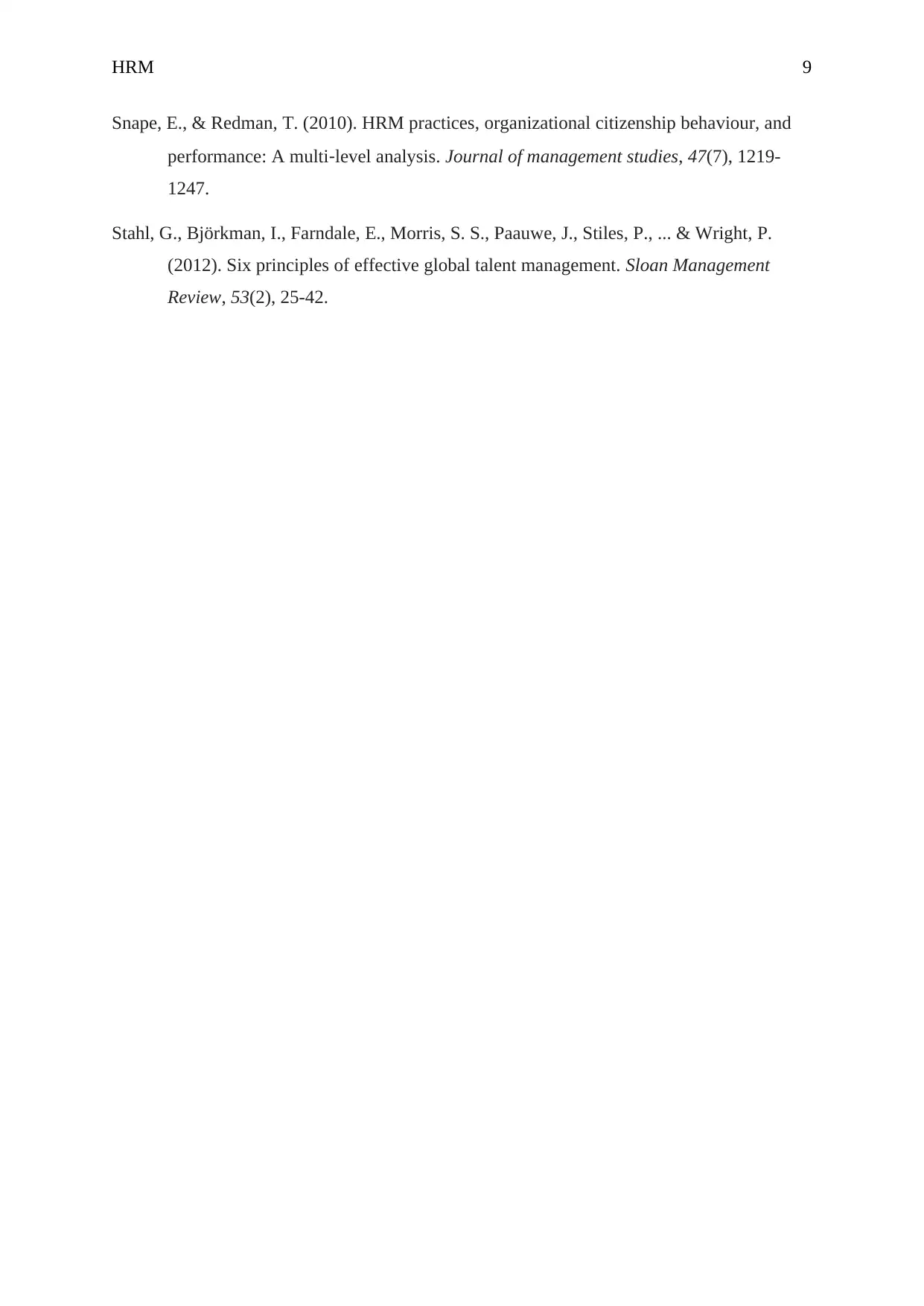
HRM 9
Snape, E., & Redman, T. (2010). HRM practices, organizational citizenship behaviour, and
performance: A multi‐level analysis. Journal of management studies, 47(7), 1219-
1247.
Stahl, G., Björkman, I., Farndale, E., Morris, S. S., Paauwe, J., Stiles, P., ... & Wright, P.
(2012). Six principles of effective global talent management. Sloan Management
Review, 53(2), 25-42.
Snape, E., & Redman, T. (2010). HRM practices, organizational citizenship behaviour, and
performance: A multi‐level analysis. Journal of management studies, 47(7), 1219-
1247.
Stahl, G., Björkman, I., Farndale, E., Morris, S. S., Paauwe, J., Stiles, P., ... & Wright, P.
(2012). Six principles of effective global talent management. Sloan Management
Review, 53(2), 25-42.
1 out of 10
Related Documents
Your All-in-One AI-Powered Toolkit for Academic Success.
+13062052269
info@desklib.com
Available 24*7 on WhatsApp / Email
![[object Object]](/_next/static/media/star-bottom.7253800d.svg)
Unlock your academic potential
Copyright © 2020–2025 A2Z Services. All Rights Reserved. Developed and managed by ZUCOL.



